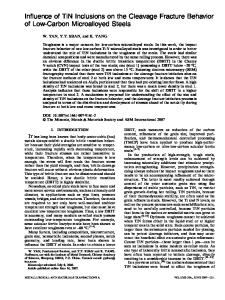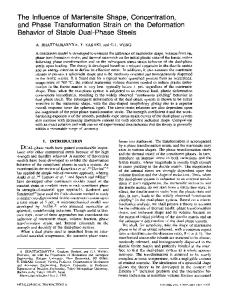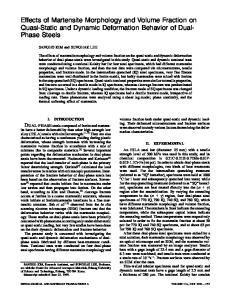Numerical Investigation of Influence of the Martensite Volume Fraction on DP Steels Fracture Behavior on the Basis of Di
- PDF / 4,536,810 Bytes
- 14 Pages / 593.972 x 792 pts Page_size
- 52 Downloads / 385 Views
INTRODUCTION
REMARKABLE need of the automotive and aerospace industries for new metallic materials that can meet stringent requirements regarding weight/property ratio has recently been observed. This need is a driving force for fast development of modern innovative steel grades. The most widely used example of those advances steels are dual-phase (DP) steels with the tensile strength of 400 to 1200 MPa. The name dual phase was first reported by Hayami and Furukawa in Reference 1. The DP steels have been successfully applied in the production of the automobile structural parts because they are characterized by a combination of good formability, high bake hardenability, and crash worthiness. These elevated properties are the results of sophisticated microstructure morphologies, which consists mainly of a ferrite matrix (around 70 to 90 pct) and a hard martensitic phase (around 10 to 30 pct). However, it has to be mentioned that small amounts of bainite, perlite, or retained austenite may also be present in the DP microstructure. Properties of DP steels are affected by many factors, including: volume fraction of martensite, average carbon content and carbon distribution in martensite, ductility of martensite, distribution of martensite, ferrite grain size, alloying elements content in ferrite etc.[2,3] KONRAD PERZYN´SKI, Researcher, and ŁUKASZ MADEJ, Professor, are with the AGH University of Science and Technology Al. Mickiewicza 30, 30-059 Cracow, Poland. Contact e-mail: kperzyns@ agh.edu.pl JINFENG WANG, Researcher, and PETER D. HODGSON, Professor, are with the Functional Fibrous Materials, Institute for Frontier Materials, Deakin University, Geelong, Victoria 3217, Australia. ROMAN KUZIAK, Professor, is with the Institute for Ferrous Metallurgy, ul. K. Miarki 12, 44-100 Gliwice, Poland. Manuscript submitted February 4, 2014. Article published online October 2, 2014 5852—VOLUME 45A, DECEMBER 2014
The most usual approaches to obtain a DP microstructure are controlled cooling after hot rolling (Figure 1(a)) or continuous annealing of cold-rolled sheets (Figure 1(b)). The former approach is usually used to produce thick DP steel strips, while the latter is used for manufacturing thin sheets often applied in the automotive industry. Nowadays, while designing new manufacturing technologies, engineers are considering not only global homogenous material behavior but also they try to incorporate micro scale phenomena like microstructure evolution or failure. As mentioned, due to strict market demands for final products with reduced weight and increased strength properties, the problem of material failure during manufacturing stages is becoming crucial. Zones where fracture can initiate during production stages should be identified and manufacturing cycle should be redesigned to avoid such behavior before industrial trials. Also extended service life of modern products require determination of failure probability during exploitation conditions. Experimental analysis can provide all the required information; however, it is tim
Data Loading...










